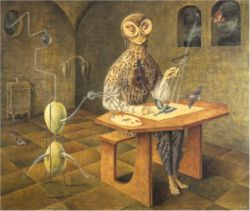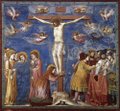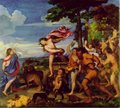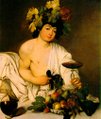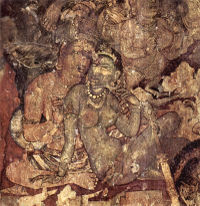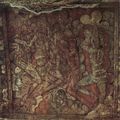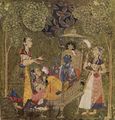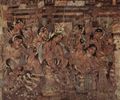Painting
2007 Schools Wikipedia Selection. Related subjects: Art
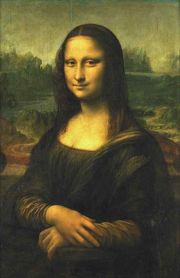
Painting taken literally is the practice of applying colour to a surface (support) such as paper, canvas, wood, glass, or other. However, when used in an artistic sense, the term "painting" means the use of this activity in combination with drawing, composition and other aesthetic considerations in order to manifest the expressive and conceptual intention of the practitioner.
Painting is used as a mode of representing, documenting and expressing all the varied intents and subjects that are as numerous as there are practitioners of the craft. Paintings can be naturalistic and representational (as in a still life or landscape painting), photographic, abstract, be loaded with narrative content, symbolism, emotion or be political in nature. A large portion of the history of painting is dominated by spiritual motifs and ideas; sites of this kind of painting range from artwork depicting mythological figures on pottery to biblical scenes rendered on the interior walls and ceiling of The Sistine Chapel to depictions of the human body itself as a spiritual subject.
Colour and tone are the essence of painting as sound and pitch are of music. Colour is highly subjective, but has observable psychological effects, although these can differ from one culture to the next. Black is associated with mourning in the West, but elsewhere white may be. Some painters, theoreticians, writers and scientists, including Goethe, Kandinsky, Newton, have written their own colour theory. Moreover the use of language is only a generalisation for a colour equivalent. The word " red", for example, can cover a wide range of variations on the pure red of the visible spectrum of light. There is not a formalised register of different colors in the way that there is agreement on different notes in music, such as C or C# in music, although the Pantone system is widely used in the commercial printing and graphic design industry for this purpose.
Modern artists have extended the practice of painting considerably to include, for example, collage which began with Cubism and is not painting in the strict sense. Some modern painters incorporate different materials such as sand, cement, straw or wood for their texture. Examples of this are the works of Jean Dubuffet or Anselm Kiefer. (There is a growing comunity of artists who use computers to literally paint colour onto a digital canvas using such programs as Photoshop, Painter, and many others. These images can be printed onto traditional canvas if required.)
In 1829, the first photograph was produced. From the mid to late 19th century, photographic processes improved and, as it became more widespread, painting lost much of its historic purpose to provide an accurate record of the observable world. There began a series of art movements into the 20th century where the Renaissance view of the world was steadily eroded, through Impressionism, Post-Impressionism, Fauvism, Expressionism, Cubism and Dadaism. Eastern and African painting, however, continued a long history of stylization and did not undergo an equivalent transformation at the same time.
Modern and Contemporary Art has moved away from the historic value of craft and documentation in favour of concept; this has led some to say that painting, as a serious art form, is dead, although this has not deterred the majority of artists from continuing to practise it either as whole or part of their work.
History of painting
Pre-history
The oldest known paintings are at the Grotte Chauvet in France, claimed by some historians to be about 32,000 years old. They are engraved and painted using red ochre and black pigment and show horses, rhinoceros, lions, buffalo, mammoth or humans often hunting. There are examples of cave paintings all over the world—in France, Spain, Portugal, China, Australia etc. Many theories have been written about these paintings with no objective conclusion. Some sustain that prehistoric men painted animals to "catch" their soul or spirit in order to hunt them more easily, others refer an animistic vision and homage to surrounding nature and others the basic need of expression that is innate to human being.
Egypt, Greece and Rome
Ancient Egypt, a civilization that is strongly connected to architecture and artistic forms, had many mural paintings in his temple and buildings. Often graphical, more symbolic than realistic in bold outline and flat, in which symmetry is a constant characteristic. Egyptian painting has close connection with its written language (see pictography) and painting had an essential role in their manuscripts ( papyrus). In fact painted symbols are amongst the first forms of written language.
To the north of Egypt was the Minoan civilization on the island of Crete. The wall paintings found in palaces such as of the Knosos are similar to that of the Egyptians. Around 1100 B.C., tribes from the north of Greece conquered Greece and the people there passed their artistic knowledge to the Greeks.
Ancient Greece had its great painters like it had great sculptors and architects, unfortunately no example of their work lasted to our days. What remains are written descriptions of their contemporaries or Roman copies. However vase painting can be as a surviving example of what Greek painting was. Some famous Greek painters who are referred in texts are Apelles, Zeuxis and Parrhasius. Zeuxis lived in 5-6 BC and was said to be the first to use sfumato. His paintings are described to be highly realistic so much that Pliny the Elder wrote that birds tried to eat the grapes of his works. Apelles is described to be the greatest painter of Antiquity for its perfect technique in drawing, brilliant colour and modeling.
Roman painting was influenced by Greek painting and can in part be taken as a descendant of ancient Greek painting. However, Roman painting does have important unique characteristics. Much of the surviving Roman painting comes down as wall paintings from the area known as Campania, in the Naples area. Such painting can be grouped into 4 main "styles" or periods and may contain the first examples of trompe-l'oeil, psuedo-perspective, and pure landscape.
Middle Ages
The rise of Christianity imparted a different spirit and aim to painting styles. Byzantium, or Byzantine art flourished after the fall of Constantinople in the Eastern Roman Empire in the 5th century AD. The main form of painting in Byzantine art is centered around the icon, usually of religious significance, depicted as a static figure on a golden background. Byzantic painting has a particularly hieratic feeling and icons were and still are seen as a reflection of the divine. Cimabue and Giotto are considered to be the two great medieval masters of painting in western culture. Cimabue, within the byzantine tradition, used a more realistic and dramatic approach to his art. His pupil, Giotto, took these innovations to a higher level which in turn set the foundations for the western painting tradition. An important form of painting in the Middle Ages is the illuminated manuscript. This type of art, now known as illustration, was widely used until the invention of the printing press. Romanesque and Gothic Styles were largely confined to monasteries in Italy and Northern Europe. There, monks made copies of Bibles and other books as well as hand-made decorations with miniature paintings and other designs called illuminations. Walls of Romanesque churches were decorated with mosaics and frescoes and the few remainig murals today show that these painters had a simple style to their religious art. The adoption of Gothic style painting and architecture in Northern Europe led to the end of the fresco. Churches were built with more and more windows and the use of colorful stained glass become a staple in decoration. One of the most famous examples of this is found in the church of Notre Dame. By the 14th century the authority of the Church had lessened significantly and painters found new patrons in the rich nobility. Illuminated manuscripts took on a new character and slim, fashionably dressed court women were shown in their landscapes. This style soon became known as International style and tempera panel paintings and altarpieces gained importance. The Gothic style never reached Italy.
Renaissance and Mannerism
The Renaissance is said to be by many the golden age of painting. In Italy artists like Paolo Uccello, Piero della Francesca, Sandro Botticelli, Leonardo Da Vinci, Michelangelo Buonarroti, Raphael and Titian took painting to a higher level through the use of perspective, the study of human anatomy and proportion, and through their development of an unprecedented refinement in drawing and painting techniques.
Flemish, Dutch and German painters of the Renaissance such as Albrecht Dürer, Lucas Cranach, Matthias Grünewald, Hieronymous Bosch and Pieter Brueghel represent a different approach from their Italian colleagues, one that is more realistic and less idealized. The adoption of oil painting (whose invention was traditionally, but erroneously, credited to Jan Van Eyck), made possible a new verisimilitude in depicting reality. Unlike the Italians whose work drew heavily from the art of ancient Greece and Rome, the northerners retained a stylistic residue of the sculpture and illuminated manuscripts of the Middle Ages.
Renaissance painting reflects the revolution of ideas and science (astronomy, geography) that occur in this period, the Reformation, and the invention of the printing press. Dürer, considered one of the greatest of printmakers, states that painters are not mere artisans but thinkers as well. With the development of easel painting in the Renaissance, painting gained independence from architecture. Following centuries dominated by religious imagery, secular subject matter returned to Western painting as artists painted the world around them, or the products of their own imaginations. Those who could afford the expense could commission portraits of themselves or their family.
In the sixteenth century, movable pictures came into popular demand, which could be hung easily on walls and moved around at will, rather than paintings being made on permanent structures, such as altars and other solid structures.
The late Renaissance gave rise to a stylized art known as Mannerism. In place of the balanced compositions and rational approach to perspective that characterized art at the dawn of the sixteenth century, the Mannerists sought instability, artifice, and doubt. The unperturbed faces and gestures of Piero della Francesca and the calm Virgins of Raphael are replaced by the troubled expressions of Pontormo and the emotional intensity of El Greco.
Baroque and Rococo
Among the greatest painters of the Baroque are Caravaggio, Rembrandt, Rubens, Velazquez and Vermeer. Caravaggio is an heir of the humanist painting of the Renaissance. His realistic approach to the human figure, painted directly from life and dramatically spotlit against a dark background, shocked his contemporaries and opened a new chapter in the history of painting. Baroque painting often dramatizes scenes using light effects; this can be seen in works by Rembrandt, Vermeer, Le Nain and La Tour.
Rococo followed as a decadent sub-genre of Baroque, lighter, often frivolous and erotic. The French masters Watteau, Boucher and Fragonard represent the style, as do Giovanni Battista Tiepolo and Thomas Gainsborough.
19th century: neo-classicism, romanticism, Impressionism
After the decadence of Rococo there arose in the late 18th century an ascetic neo-classicism, best represented by such artists as David and his heir Ingres. Ingres' work already contains much of the sensuality, but none of the spontaneity, that was to characterize Romanticism. This movement turned its attention toward landscape and nature as well as the human figure and the supremacy of natural order above mankind's will. There is a pantheist philosophy (see Spinoza and Hegel) within this conception that opposes Enlightenment ideals by seeing mankind's destiny in a more tragic or pessimistic light. The idea that human beings are not above the forces of Nature is in contradiction to Ancient Greek and Renaissance ideals where mankind was above all things and owned his fate. This thinking led romantic artists to depict ruined churches, shipwrecks, massacres and madness.
Romantic painters turned landscape painting into a major genre, considered until then as a minor genre or as a decorative background for figure compositions. Some of the major painters of this period are Eugene Delacroix, J. M. W. Turner, Caspar David Friedrich and John Constable. Francisco de Goya's late work demonstrates the Romantic interest in the irrational, while the work of Arnold Böcklin evokes mystery.
Camille Corot painted sometimes as a romantic, sometimes as a realist who looks ahead to Impressionism. A major force in the turn towards realism at mid-century was Courbet. In the latter third of the century Impressionists like Monet and Degas and the slightly younger post-Impressionists like Vincent Van Gogh, Paul Gauguin and Paul Cezanne lead art up to the edge of modernism.
Modern and Contemporary
|
|
|
||
|
|
The heritage of painters like Van Gogh, Cezanne and Gauguin was essential for the development of modern art. Picasso made his first cubist paintings based in the idea, created by Cezanne, that all depiction of nature can be reduced to three solids: cube, sphere and cone. After cubism several movements emerged; Futurism ( Balla), Abstract ( Kandinsky, Der Blaue Reiter, Mondrian), Suprematism ( Malevich), Constructivism ( Tatlin), Dadaism ( Duchamp, Arp) and Surrealism (Dali, Ernst). Modern painting influenced all visual arts, from architecture to design and became an experimental laboratory in which artists stretched the limits of this medium to his extreme. Van Gogh's painting had great influence in Expressionism which can be seen in Die Brücke, a group lead by German painter Ernst Kirchner and in Edvard Munch or Egon Schiele's work.
Post-second world war painting renewed Abstract art with artists like Jackson Pollock and Vieira da Silva and as a response to this tendence Pop-Art emerged with names like Andy Warhol and Roy Lichtenstein, trying to take popular and mass culture into fine art.
During the 1960's and 1970's, there was a reaction against painting. Critics began to veiw it as infected by consumerism and commodification, and as an artistic hegemony. Artists like Ad Reinhardt declared the 'death of painting'. New movements gained prominence; arte povera, performance art, body art, fluxus, the situationists and most importantly, conceptual art. This trend to distance art from painting occurred throughout the 1970's. In the late 1970's and early 1980's, there was a return to painting that occurred almost simultaneously in Canada,Italy, Germany, United States and Britain. These movements were called Transpressionism, Transavantguardia, Neue Wilde, Neo-expressionism, and the School of London respectively. These painting were characterized by large formats, free expressive mark making, figuration, myth and imagination. They were a reaction against not only conceptual art, but what was veiwed as the sterile abstraction of high modernism before it. Perhaps this new wave of paintings could be encapsulated by Guity Novin's statement that 'Artificiality is a deathtrap. Art is birth.' All work in this genre (with the exception of Transpressionism) came to be labeled neo-expressionism. Critical reaction was divided. Some critics regarded it as driven by profit motivations by large commercial galleries. Today this genre holds a respected position alongside installation art, the major vehicle for academics and the artistic vanguard.
Contemporary, or post-modern painting is an open field no longer divided by the objective vs non-objective dichotomy. Artists can achieve critical success whether their images are representational or abstract. What has currency is content, exploring the boundaries of the medium, and a refusal to recapitulate the works of the past as an end goal.
Islam
The depiction of humans, animals or any another figurative subjects is forbidden within Islam to prevent believers from idolatry so there is no religiously motivated painting (or sculpture) tradition within Muslim culture. Pictorial activity was reduced to Arabesque, mainly abstract, with geometrical configuration or floral and plant-like patterns. Strongly connected to architecture and calligraphy, it can be widely seen as used for the painting of tiles in mosques or in illuminations around the text of the holy Koran and other books. In fact abstract art is not an invention of modern art but it is present in pre-classical, barbarian and non-western cultures many centuries before it and is essentially a decorative or applied art. Notable illustrator M.C. Escher was influenced by this geometrical and pattern based art. Art Nouveau ( Aubrey Beardsley and the architect Antonio Gaudi) re-introduced abstract floral patterns into western art.
Note that despite the taboo of figurative visualization, some muslim countries did cultivate a rich tradition in painting, though not in its own right, but as a companion to the written word. Iranian or Persian art, widely known as Persian miniature, concentrates on the illustration of epic or romantic works of literature. Persian illustrators deliberately avoided the use of shading and perspective, though familiar with it in their pre-islamic history, in order to abide by the rule of not creating any life-like illusion of the real world. Their aim was not to depict the world as it is, but to create images of an ideal world of timeless beauty and perfect order.
In present days, painting by art students or professional artists in arab and non-arab muslim countries follow the same tendencies of Western culture art.
Iran
Oriental historian Basil Gray believes "Iran has offered a particularly unique [sic] art to the world which is excellent in its kind".
Caves in Iran's Lorestan province exhibit painted imagery of animals and hunting scenes. Some such as those in Fars Province and Sialk are at least 5,000 years old.
Painting in Iran is thought to have reached a climax during the Tamerlane era when outstanding masters such as Kamaleddin Behzad gave birth to a new style of painting.
Paintings of the Qajar period, are a combination of European influences and Safavid miniature schools of painting such as those introduced by Reza Abbasi. Masters such as Kamal-ol-molk, further pushed forward the European influence in Iran. It was during the Qajar era when "Coffee House painting" emerged. Subjects of this style were often religious in nature depicting scenes from Shia epics and the like.
Far east
China, Japan and Korea have a strong tradition in painting which is also highly attached to the art of calligraphy and printmaking (so much that it is commonly seen as painting). Far east traditional painting is characterized by water based techniques, less realism, "elegant" and stylized subjects, graphical approach to depiction, the importance of white space (or negative space) and a preference for landscape (instead of human figure) as a subject.
Late 19th century artists like the Impressionists, Van Gogh, James Ensor or Whistler admired traditional painters like Hokusai and Hiroshige and their work was influenced by it.
India
Indian paintings historically revolved around the religious deities and kings. Indian art is a collective term for several different schools of art which existed the Indian sub-continent. The paintings varied from large frescoes of Ellora to the intricate Mughal miniature paintings to the metal embellished works from the Tanjore school. The paintings from the Gandhahar-Taxila are influenced by the Persian (Iran) works in the west. The eastern style of painting was mostly developed around the Nalanda school of art. The works are mostly inspired by various scenes from Indian mythology.
History
The earliest Indian paintings were the rock paintings of prehistoric times, the petroglyphs as found in places like Bhimbetka, and some of them are older than 5500 BC. Such works continued and after several millennia, in the 7th century, carved pillars of Ellora, Maharashtra state present a fine example of Indian paintings, and the colors, mostly various shades of red and orange, were derived from minerals. Thereafter, frescoes of Ajanta and Ellora caves appeared. India’s Buddhist literature is replete with examples of texts which describe that palaces of kings and aristocratic class were embellished with paintings, but they have not survived. But, it is believed that some form of art painting was practiced in that time.
- Madhubani painting
Madhubani painting is a style of Indian painting, practiced in the Mithila region of Bihar state, India. The origins of Madhubani painting are shrouded in antiquity, and a tradition states that this style of painting originated at the time of the Ramayana, when King Janak commissioned artists to do paintings at the time of marriage of his daughter, Sita, with Sri Rama who is considered to be an incarnation of the Hindu god lord Vishnu.
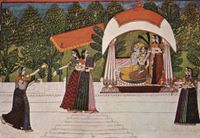
- Rajput painting
Rajput painting, a style of Indian painting, evolved and flourished, during the 18th century, in the royal courts of Rajputana, India. Each Rajput kingdom evolved a distinct style, but with certain common features. Rajput paintings depict a number of themes, events of epics like the Ramayana and the Mahabharata, Krishna’s life, beautiful landscapes, and humans. Miniatures were the preferred medium of Rajput painting, but several manuscripts also contain Rajput paintings, and paintings were even done on the walls of palaces, inner chambers of the forts, havelies, particularly, the havelis of Shekhawait.
The colors extracted from certain minerals, plant sources, conch shells, and were even derived by processing precious stones, gold and silver were used. The preparation of desired colors was a lengthy process, sometimes taking weeks. Brushes used were very fine.
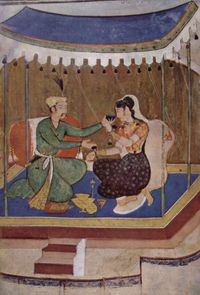
- Mughal painting
Mughal painting is a particular style of Indian painting, generally confined to illustrations on the book and done in miniatures, and which emerged, developed and took shape during the period of the Mughal Empire 16th -19th centuries).
- Tanjore painting
Tanjore painting is an important form of classical South Indian painting native to the town of Tanjore in Tamil Nadu. The art form dates back to the early 9th Century, a period dominated by the Chola rulers, who encouraged art and literature. These paintings are known for their elegance, rich colors, and attention to detail. The themes for most of these paintings are Hindu Gods and Goddesses and scenes from Hindu mythology. In modern times, these paintings have become a much sought after souvenir during festive occasions in South India.
The process of making a Tanjore painting involves many stages. The first stage involves the making of the preliminary sketch of the image on the base. The base consists of a cloth pasted over a wooden base. Then chalk powder or zinc oxide is mixed with water-soluble adhesive and applied on the base. To make the base smoother, a mild abrasive is sometimes used. After the drawing is made, decoration of the jewellery and the apparels in the image is done with semi-precious stones. Laces or threads are also used to decorate the jewellery. On top of this, the gold foils are pasted. Finally, dyes are used to add colors to the figures in the paintings.
The Madras School
During British rule in India, the crown found that Madras had some of the most talented and intelectual artistic minds in the world! As the Britishers had also established a huge settlement in and around Madras, Georgetown was chosen to establish an institute that would cater to the artistic expectations of the royals in London. At first tradional artists were employed to produce exquisite varieties of furniture, metal work, curios etc. and the masterpieces were sent to the royal palaces of the queen. In a very short period this institute established itself as the first school of art in India! It predates even the famous Madras University. Today this institute can be found in Periamet, Chennai. Now it is named as The Govt; College of Finearts.
Most of the famous Painters, Sculptors and Craftsmen of India either are products of this college or are influenced by this college. The stamp of this college can be found in each and every painting or sculpture that is being produced in India. Indian art history will not be complete without the prominent mention of the Govt; College of Finearts-no matter whoever denies it.
The most prominent artists to come from this school lately (apart from numerous other fields that this college has influenced) are Santhanaraj(painting and sculpture),Munusamy(painting),Adimoolam(drawing and painting),Chandrasekar(painting and sculpture),Roy choudry(sculpture),KCS Paniker,Kanniappan(sculpture),Palaniappan(printing),Adhiveerapandian(painting),Michaelirudayaraj(painting)and numerous other personalities who are spread all over the world.
Unlike the Bengal School where 'copying' is the norm of teaching, the Madras school flourishes on 'creating' new styles, arguments and trends!
- Bengal school
The Bengal School of Art was an influential style of art that flourished in India during the British Raj in the early 20th century. It was associated with Indian nationalism, but was also promoted and supported by many British arts administrators.
The Bengal school arose as an avant garde and nationalist movement reacting against the academic art styles previously promoted in India, both by Indian artists such as Ravi Varma and in British art schools. Following the widespread influence of Indian spiritual ideas in the West, the British art teacher Ernest Binfield Havel attempted to reform the teaching methods at the Calcutta School of Art by encouraging students to imitate Mughal miniatures. This caused immense controversy, leading to a strike by students and complaints from the local press, including from nationalists who considered it to be a retrogressive move. Havel was supported by the artist Abanindranath Tagore, a nephew of the poet Rabindranath Tagore. Tagore painted a number of works influenced by Mughal art, a style that he and Havel believed to be expressive of India's distinct spiritual qualities, as opposed to the "materialism" of the West. Tagore's best-known painting, Bharat Mata (Mother India), depicted a young woman, portrayed with four arms in the manner of Hindu deities, holding objects symbolic of India's national aspirations. Tagore later attempted to develop links with Japanese artists as part of an aspiration to construct a pan-Asianist model of art.
The Bengal school's influence in India declined with the spread of modernist ideas in the 1920s.
Modern Indian painting
Modern Indian painting is trying to break free from the shackles imposed by a post-colonial Modernistic imperative to depict art solely from an Indian point of view. You had to paint the same village scenes, urban squalor, folk themes traditionally linked with what was supposed to be truly Indian - the entire snake charmer, bullock cart bias. There was also this strange need to depict abstract imagery, and talented painters with skill, sensitivity and deep artistic perception were considered 'western' or 'illustrative' if they pursued their heart's calling and painted in a visually realistic manner. If the "form wasn't broken" enough, it wasn't considered Indian Modern Art.
But painters such as Hemen Majumder, Atul Bose, and later Bikash Bhattacharjee and Ganesh Pyne defied such puedo-Modernistic compulsions and continued to paint their hearts out. The breathtaking array of their work, the rich visual splendour and the self-evident talent instills awe in the eyes of the beholder and these painings continue to grow in the mind long after they were seen for the first time. Ganesh Pyne is a bit different in the sense that he was created a style where images traverse a peculiar bridge between the flat surface of canvas and 3D illusion.
More recently a new generation of painters have come up who are secure in their Indian-ness, open to the world and its artistic trends and traditions, especially in this age of the internet and wikipedia, have a vision that looks far beyond parochial and critque driven limits and explores art to the best of their skill and imagination. These are the Meta-realists who are gifted enough to depict their vision of reality on canvas, and liberated enough to not get stuck by their Indian roots. Prosenjit Roy's meta-realistic paintings straddle the fine gap between an imaginative recreation of the visible world and a hallucinatory vision of the inner self. According to some, there is another group - the Pseudo-realists. Devajyoti Ray is one such painter. his style beyond the confines of Art-school grammar explores colors in a pseudo-realist perpective.
These new artists are neither dogged by nationalistic insecurities, secure as they are in their Indian-ness, nor by the age old debate of Modernism. They have created their own niche in a post modern, culturally interlinked but wonderully heterogeneous world.
Sanjay Bhattacharya, a more senior painter and from a classical academically trained background who paints with a brooding sense of devotion is also a very successful artist in this genre of Modern Indian painting.
Africa
African traditional culture and tribes do not seem to had great interest in two-dimensional representations in favour of Sculpture. However, decorative painting in African culture is often abstract and geometrical. Another pictorial manifestation is body painting, present for example in Maasai culture in their ceremony rituals. Note that Pablo Picasso and other modern artists were influenced by African sculpture in their styles. Contemporary African artists follow western art movements and their paintings have little difference from occidental art works.
Aesthetics and theory of painting
Aesthetics tries to be the "science of beauty" and it was an important issue for 18th and 19th century philoshopers like Kant or Hegel. Classical philosophers like Plato and Aristotle also theorized about art and painting in particular; Plato disregarded painters (as well as sculptors) in his philosophical system, sustaining that a painting is a copy of reality (a shadow of the world of ideas so it cannot depict the truth) and is nothing but a craft, similar to shoemaking or iron casting. Leonardo Da Vinci, on the contrary, said that "Pittura est cousa mentale" (painting is an intellectual thing). Kant identified Beauty with the Sublime, not referring particularly to painting, but this concept was taken by painters like Turner or Caspar David Friedrich. Hegel recognized the failure of attaining a universal concept of beauty and in his aesthetic essay wrote that Painting is one of the three "romantic" arts, along with Poetry and Music for its symbolic, highly intellectual purpose. Painters like Kandinsky or Paul Klee also wrote theory of painting. Kandinsky in its essay sustains that painting has a spiritual value also he attaches primary colors to essential feelings or concepts, something that writers like Goethe had already tried to do.
Iconography has also something to say about painting. The creator of this discipline, Erwin Panofsky, tries to analyse visual symbols in their cultural, religious, social and philosophical depth to attain a better comprehension of mankind's symbolic activity.
Beauty, however, a concept of which Painting is essentially linked, cannot be defined as an objective matter, purpose or idea. Much aesthetics and theory of art is connected with painting. In 1890, the Parisian painter Maurice Denis famously asserted: "Remember that a painting – before being a warhorse, a naked woman or some story or other – is essentially a flat surface covered with colors assembled in a certain order." Thus, many twentieth century developments in painting, such as Cubism, were reflections on the business of painting rather than on the external world, nature, which had previously been its core subject.
Julian Bell (1908-37), a painter himself, examines in his book What is Painting? the historical development of the notion that paintings can express feelings and ideas:
- Let us be brutal: expression is a joke. Your painting expresses – for you; but it does not communicate to me. You had something in mind, something you wanted to ‘bring out’; but looking at what you have done, I have no certainty that I know what it was....
Popular painting styles
'Style' is used in two senses: It can refer to the distinctive visual elements, techniques and methods that typify an individual artist's work. It can also refer to the movement or school that an artist is associated with. This can stem from an actual group that the artist was consciously involved with or it can be a category in which art historians have placed the painter. The word 'style' in the latter sense has fallen out of favour in academic discussions about contemporary painting, though it continues to be used in popular contexts.
Painting styles
- Abstract
- Abstract expressionism
- Post-Abstract Expressionism
- Art Brut
- Baroque
- Colour Field
- Constructivism
- Contemporary Art
- Cubism
- Expressionism
- Fauvism
- Folk
- Graffiti
- Hard-edge
- Impressionism
- Lyrical Abstraction
- Mannerism
- Minimalism
- Modernism
- Naïve art
- Neo-classicism
- Op art
- Orientalism
- Orphism
- Outsider
- Painterly
- Photorealism
- Pointillism
- Pop art
- Postmodernism
- Post-painterly Abstraction
- Primitive
- Pseudorealism
- Realism
- Rectoversion
- Romanticism
- Romantic realism
- Socialist realism
- Stuckism
- Surrealism
- Tachism
- Transpressionism
Common painting idioms
Painting idioms include:
- Allegory
- Bodegon
- Body painting
- Botanical
- Figure painting
- Illustration
- Industrial
- Landscape
- Portrait
- Still life
- War
Some other painting terms are:
Altarpiece, Broken Colour, Cartoon, Composition, Drybrush, Easel Picture, Foreshortening, Genre, Halo, Highlights, History painting, Imprimatura, Landscape, Madonna, Maulstick, Miniature, Mural Painting, Palette, Panel Painting, Perspective, Pietá, Plein Air, Portrait, Stippling, Technique, Trompe l'oeil, Underpainting, Varnish, Wet-on-wet and Four-dimensional painting.
